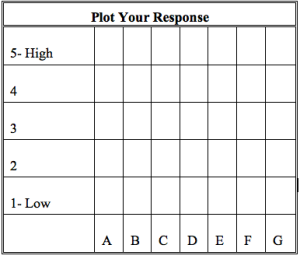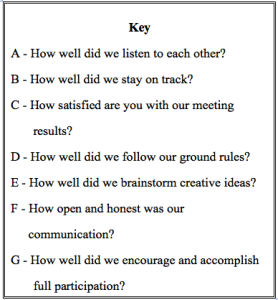“My team is very exacting and likes to use quantitative ratings. Is there a meeting evaluation technique I can use that satisfies this criterion?”
#3 Team Effectiveness Chart
What is a Team Effectiveness Chart?
A Team Effectiveness Chart visually and quantifiably measures specific aspects of your meeting, such as level of open communication, satisfaction with results accomplished, how well the group honors the ideas of others, or other components of the meeting. The resulting measurements are charted on grids with numerical rankings.
A Team Effectiveness Chart serves as a visual aid to display quantified group ratings. This chart can also be used as a benchmark for later evaluations.
When to Use a Team Effectiveness Chart
- When you want to get feedback on specific criteria
- When you want feedback that is measurable
- When you want to include everyone in non-verbal feedback
- When you want to get feedback quickly about the quality of your meetings
How to Use a Team Effectiveness Chart
Before the Meeting:
- Add Team Effectiveness Chart to the end of the meeting’s agenda. Allow 15 minutes for rankings and a debriefing discussion.
- Decide which components of your meeting are appropriate for the group to measure for effectiveness. You may want to consult with other meeting participants in determining these categories. Your group’s meeting ground rules will offer a springboard for ideas.
- Possible examples of these components include:
- How well we listened to each other
- How well we stayed on track
- How satisfied we are with the results of our meeting
- How well we followed our ground rules
- How well we brainstormed creative ideas
- How open and honest our communication was
- How well we encouraged and accomplished full participation
- How comfortable participants felt about speaking their mind
- Create charts similar to the two illustrated below.
NOTE: If your meeting group is large, consider duplicating the information on two or three charts instead. This will avoid crowding while participants place their marks.
NOTE: This process could also be done electronically.
During the Meeting:
- Introduce the Team Effectiveness Chart technique. If this is the first time your group is using this technique, explain what it is used for and how to use it. You might say, for example, “Team Effectiveness Chart is a technique for visually measuring your feedback about our meeting. These measurements will allow us to look at our strengths and weaknesses as a meeting group. We can then look for methods to improve our effectiveness in our upcoming meetings. We can also use these measurements as a benchmark. After we work to improve, we can measure ourselves again and see what progress we have made.” Share the measurements you will be employing, using your charts to support you. Explain how and why the components being measured were determined.
- Ask every participant to come forward and mark how well they think the team did in each category under consideration. They should indicate their ratings by putting a large dot on the chart in the appropriate place. You may provide sticky dots or markers for this exercise.
- After everyone is finished and seated, debrief the information as a group. Here are some sample questions that may be appropriate. “As you look at our chart, what stands out for you?” “What conclusions can we draw from this information?” “What are we particularly good at?” “What would you say are our major opportunities for improvement?” “What should we target as actions for improving our meetings?” “How should we accomplish these actions?” Chart the group’s responses and create a list of action items based on the major opportunities for improvement.
- After the meeting, keep the charts your team has developed. Be sure to write the date on each of them.
- Benchmark your group’s progress in the next meeting or in whichever future meeting you and your group feel is appropriate. Compare your progress against the first measurement.
- Repeat Steps 1 and 2 but on a new chart.
- To debrief, bring out the old chart, and place it next to its counterpart from today’s meeting.
- As a group, measure numerically the difference between your previous rankings and this meeting’s rankings.
- Use or modify the debrief questions in Step 3. Create a new action plan as necessary. You might also consider bringing out your old action plan to see if you have accomplished those actions yet.
- Keep the charts or a summary of the charts (or photos of them) for benchmarking in the future.
In Summary:
Team Effectiveness Chart is a technique with which your meeting participants measure the effectiveness of specific meeting components.
Before the Meeting:
- Add Team Effectiveness Chart to the end of the meeting’s agenda.
- Decide which components of your meeting are appropriate for the group to measure for effectiveness.
- Create charts similar to those above.
During the Meeting:
- Introduce the Team Effectiveness Chart technique, using your charts to support you.
- Ask every participant to come forward and mark how well they think the team did in each category under analysis.
- Debrief the information as a group and create an action list based on the major opportunities for improvement.
- After the meeting, date and keep the charts for Step 5.
- In a later meeting, benchmark your group’s progress.
- Repeat Steps 1 and 2 but on a new chart.
- To debrief, bring out the old chart, and place it next to its counterpart from today’s meeting.
- As a group, measure numerically the difference between your previous rankings and this meeting’s rankings.
- Use or modify the debrief questions in Step 3, creating a new action plan as necessary.
- Keep the charts or a summary of the charts for benchmarking in the future.
___________________________
NOTE:
If you would like to receive e-mail notification when I post additional techniques, please sign up through this link. http://eepurl.com/KILan You may unsubscribe at any time.
You will find my book Mission Critical Meetings: 81 Practical Facilitation Techniques on Amazon. Your feedback and reviews are most welcome.

